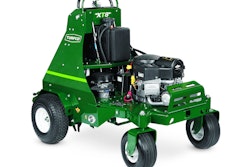 Photo: BOSS Snowplow
Photo: BOSS SnowplowIn the spirit of snow plowing, here are some of the basic plowing practices from BOSS Snowplow to remember while you’re out clearing roads and parking lots:
- Before it snows, explore the properties you have to plow. Note items like speed bumps, shrubs, water drains, pipes, sidewalk edges and the like to prevent damage to the plow and area being plowed. Mark objects that will be hard to see after a snowfall.
- Plan your plowing pattern so you drive forward as much as possible.
- Come to a complete stop before shifting into reverse.
- When in reverse, do not rely on vehicle mirrors. Turn and look where you’re going.
- Do not exceed 40 mph when transporting a plow. Do not exceed 14 mph when plowing.
- When plowing on dirt or gravel, lower the plow shoes. This will prevent the blade from scraping the surface away.
- When plowing on asphalt or concrete, raise or remove the plow shoes to scrape the surface as close as possible.
- When you are done plowing, lower the blade to the ground and turn the plow control off for safety. It will also take stress of the hydraulic components.
Plowing parking lots
If you are responsible for clearing sidewalks as well as the parking lot, shovel these first so that this snow can be plowed away as well.
Plow areas in front of buildings and overhead doors first. With the blade raised, drive up to the building and drop the blade to drag the snow away from the building. Turn your vehicle around and back into the cleared area and then push the snow to the outer edges of the lot.
After back dragging the front of the buildings, start by making a pass down the center of the lot. Push snow in windrows to the outer edges. If there is going to be a significant amount of snowfall, push as much bulk off the lots as possible. For larger lots, break the plowing up into smaller sections.
Plow in straight lines whenever possible and keep wind direction in mind. Piling downwind will prevent drifting. Do not pile snow near handicapped parking areas or by the road where it blocks the visibility of cars leaving or entering the parking lot.
Preparing for heavy snow storms
When heavy amounts of snow are expected, it is better to plow during the storm rather than letting it accumulate. If snow gets too deep it can become near impossible to plow and the longer it sits the more likely it will harden.
Plowing during snow storms means snow and ice covered roads on the way to client’s property, high winds and low visibility. Always make sure that your plow and vehicle are in top working condition. Check the fluid levels, tire pressure, battery, and lights. You should keep an emergency kit for both yourself and your snowplow.
Your snowplow kit should have extra hydraulic fluid, hydraulic hoses, a pump solenoid, extra cutting-edge bolts and a trip spring. Your emergency kit should include a flashlight, flares, an ice scraper, jumper cables, a first aid kit, extra clothing, a blanket, shovel, gloves, water and snacks, and a phone or two-way radio.









